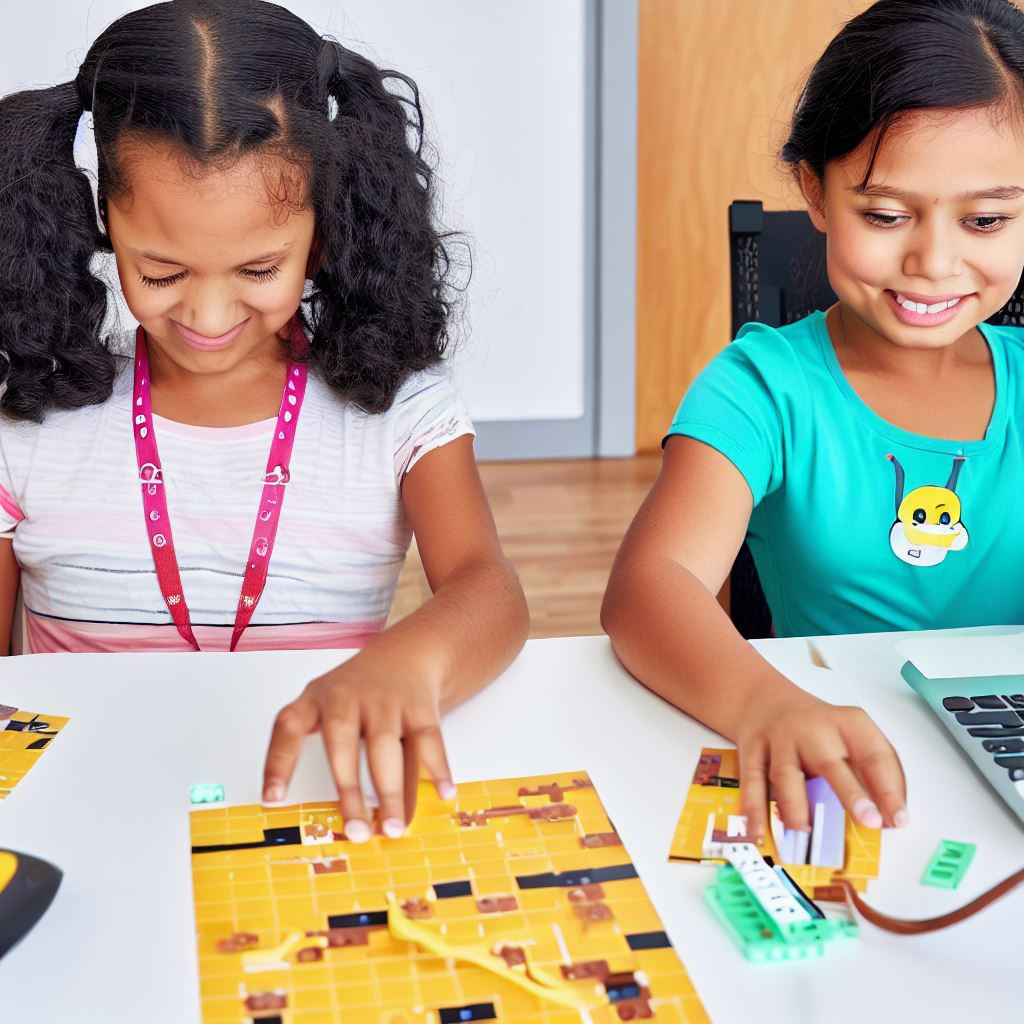Introduction
Accessibility in Coding Schools: Creating an inclusive learning environment is crucial in coding schools for several reasons.
Accessibility in the context of coding schools refers to ensuring that all individuals, regardless of their abilities, can access and participate in programming education.
By prioritizing accessibility, coding schools can accommodate individuals with disabilities, allowing them to learn and thrive in the field of coding.
Accessibility is crucial for creating an inclusive learning environment because it promotes diversity and equal opportunities for all.
When coding schools prioritize accessibility, they remove barriers that may prevent individuals from learning or participating fully in coding programs.
By providing accessible resources and tools, coding schools can empower individuals with disabilities to pursue their passion for coding and succeed in the field.
Moreover, accessibility fosters a sense of belonging and community within coding schools, as all individuals feel valued and included.
When coding schools prioritize accessibility, they send a powerful message that everyone’s learning needs and experiences are important and respected.
Overall, incorporating accessibility practices in coding schools is fundamental for creating an inclusive learning environment that enables individuals of all abilities to thrive and succeed in coding.
Understanding the Challenges Faced by Individuals with Disabilities
Individuals with disabilities face unique challenges when it comes to accessing and participating in coding schools. These challenges can range from physical limitations to cognitive impairments.
A. Different types of disabilities that can affect learning coding
One of the most common types of disabilities that can affect learning coding is physical disabilities.
These include conditions such as mobility impairments, limb differences, and chronic illnesses.
These individuals may face difficulties in navigating physical spaces, using certain tools or equipment, and even in sitting for long periods of time.
Another type of disability that can impact learning coding is visual impairment.
People who are blind or have low vision may struggle with reading code on screens or printed materials, as well as with visualizing concepts and diagrams.
Tech Consulting Tailored to Your Coding Journey
Get expert guidance in coding with a personalized consultation. Receive unique, actionable insights delivered in 1-3 business days.
Get StartedThey may rely on screen readers or assistive technologies to access and understand the content.
Hearing impairments are yet another challenge that individuals with disabilities may face in coding schools.
They may have difficulty following verbal instructions in class or during group discussions.
Transcriptions or captioning can help make the content accessible, but there may still be limitations in participation and communication.
B. Exploring how these disabilities can impact the learning process
The presence of disabilities can significantly impact the learning process for individuals in coding schools.
Learning and understanding complex coding concepts may take longer due to the need for alternative approaches.
This can lead to feelings of frustration and a sense of falling behind.
Additionally, individuals with disabilities may require additional accommodations and support to fully engage in the learning experience.
This can involve the use of assistive technologies, modified learning materials, and accessible physical environments.
C. Examples of common challenges faced by students with disabilities in coding schools
Students with physical disabilities may struggle with accessing certain areas of the coding school, such as labs or workstations.
They may also face challenges in using specific hardware or using coding tools that are not designed with accessibility in mind.
For individuals with visual impairments, reading code and accessing visual programming environments can be a significant hurdle.
They may require screen magnification software or Braille displays to navigate and understand the content.
Students with hearing impairments may face difficulties following lectures or participating in group projects that heavily rely on verbal communication.
Build Your Vision, Perfectly Tailored
Get a custom-built website or application that matches your vision and needs. Stand out from the crowd with a solution designed just for you—professional, scalable, and seamless.
Get StartedProviding visual alternatives, such as closed captions or sign language interpreters, can help make the learning environment more inclusive.
It is vital for coding schools to understand the challenges faced by individuals with disabilities and work towards creating inclusive learning environments.
By recognizing the different types of disabilities and their impact on the learning process, schools can implement appropriate accommodations and support systems.
Through thoughtful consideration and accessible practices, coding schools can ensure equal opportunities for individuals with disabilities to succeed in their coding journey.
Read: Is Coding School Right for Career-Changers?
Strategies for Promoting Accessibility in Coding Schools
Coding schools have become increasingly popular as more people seek to pursue careers in technology and software development.
However, ensuring accessibility for students with disabilities in these schools remains a challenge.
In this blog section, we will explore various strategies that can be implemented to promote accessibility in coding schools.
A. Incorporating Assistive Technologies and Tools for Students with Disabilities
- Provide assistive devices such as screen readers, Braille displays, and adaptive keyboards.
- Train instructors and staff on how to use and support these assistive technologies.
- Collaborate with disability service providers to identify specific needs and provide tailored solutions.
B. Providing Alternative Formats for Instructional Materials
- Create transcripts for all videos and audio content to ensure access for students with hearing impairments.
- Offer captioning or sign language interpretation for live lectures and presentations.
- Provide accessible PDF versions of written materials for students who use screen readers.
C. Designing Coding Curriculum and Activities for Diverse Learners
- Integrate universal design principles into coding curriculum to address the diverse learning needs of students.
- Offer multiple modes of instruction, such as visual, auditory, and kinesthetic, to cater to different learning styles.
- Provide coding exercises with varying levels of difficulty to accommodate students of different skill levels.
- Incorporate inclusive examples and projects that reflect diverse backgrounds and experiences.
D. Ensuring Physical Accessibility within Coding School Premises
- Ensure coding school facilities are wheelchair accessible with ramps, elevators, and wide doorways.
- Provide accessible restrooms equipped with grab bars and accessible sinks.
- Install assistive listening systems in classrooms and lecture halls for students with hearing impairments.
- Train staff and faculty on disability etiquette and awareness to create an inclusive environment.
By implementing these strategies, coding schools can create a more inclusive and accessible learning environment for students with disabilities.
It is essential to prioritize accessibility and continuously evaluate and improve upon existing practices to ensure equal opportunities for all learners.
Read: Coding Bootcamps for Teens: What Parents Need to Know

Building a Supportive and Inclusive Community
In order to ensure accessibility in coding schools, it is crucial to build a supportive and inclusive community.
This can be achieved through various strategies which promote a culture of empathy and understanding.
A. Promoting a Culture of Empathy and Understanding within Coding Schools
Creating a culture of empathy and understanding is essential to fostering a supportive environment for all students, including those with disabilities.
Optimize Your Profile, Get Noticed
Make your resume and LinkedIn stand out to employers with a profile that highlights your technical skills and project experience. Elevate your career with a polished and professional presence.
Get NoticedCoding schools can achieve this by:
- Educating students and staff about the challenges faced by individuals with disabilities.
- Raising awareness about the importance of accessibility and the benefits of inclusion.
- Encouraging students to develop empathy and respect for their peers.
- Organizing sensitivity training sessions to enhance understanding and reduce biases.
B. Encouraging Open Communication and Dialogue
Open communication and dialogue are vital to address the specific needs and concerns of students with disabilities.
Coding schools can foster this by:
- Creating a safe and inclusive space for students to share their experiences and challenges.
- Establishing channels for students to provide feedback and suggestions for improvement.
- Encouraging instructors and staff to actively listen to students’ concerns and provide timely support.
- Regularly evaluating the effectiveness of accessibility measures and making necessary adjustments.
C. Establishing Peer Support Networks and Mentorship Programs
Peer support networks and mentorship programs play a crucial role in providing assistance and guidance to students with disabilities.
Coding schools can implement these initiatives by:
- Pairing students with disabilities with mentors who have similar experiences or expertise.
- Creating online communities or forums where students can connect, seek advice, and share resources.
- Organizing regular meetups or events to facilitate networking and collaboration among students.
- Providing accessible resources and materials for peer support and mentorship activities.
D. Hosting Events or Workshops Focused on Accessibility and Inclusion
Hosting events or workshops centered around accessibility and inclusion helps to promote awareness and understanding within coding schools.
Some effective approaches include:
- Inviting guest speakers with a background in accessibility to share their knowledge and experiences.
- Organizing coding challenges or hackathons that encourage participants to develop accessible applications.
- Collaborating with local organizations advocating for disability rights to co-host informative sessions.
- Offering scholarships or discounts for individuals with disabilities to attend coding bootcamps.
Coding schools can ensure accessibility by building a supportive and inclusive community.
By promoting empathy, encouraging open communication, establishing peer support networks, and hosting events focused on accessibility and inclusion, coding schools can create an environment that caters to the diverse needs of all students.
Read: Coding School Alumni: Where Are They Now?
Case Studies of Successful Accessibility Initiatives in Coding Schools
In recent years, coding schools have been striving to make their programs more accessible for students with disabilities.
Through various initiatives, these schools have successfully implemented measures to improve accessibility, resulting in positive outcomes for disabled students.
Let’s explore some case studies that highlight such initiatives and their impact.
A. Highlighting coding schools that have successfully implemented accessibility measures
Several coding schools are commendable for their successful implementation of accessibility measures, making learning more inclusive and providing equal opportunities for disabled students.
1. Access Code: A Model of Inclusivity
- Coding School A, a leading institution, recognized the need for accessibility and invested in infrastructure upgrades.
- They implemented screen reader compatibility, keyboard accessibility, and software customization options.
- As a result, visually impaired students could access course materials, participate in coding exercises, and excel in their studies.
- Coding School A’s commitment to inclusivity fostered a sense of belonging and boosted the morale of disabled students.
2. Coding Dojo: Embracing Assistive Technologies
- Coding School B adopted a multi-faceted approach by embracing assistive technologies and providing specialized resources.
- They collaborated with accessibility experts to develop custom software and tools for students with various disabilities.
- With the introduction of tactile interfaces and voice-controlled programming environments, students with motor impairments gained independence.
- Coding School B’s comprehensive accessibility measures not only empowered disabled students but also inspired other institutions to follow suit.
3. Flatiron School: Prioritizing Universal Design
- Coding School C has incorporated universal design principles into their curriculum and learning materials.
- By using clear language, descriptive headings, and providing alt-text for images, they ensure content accessibility.
- Moreover, they offer flexible learning options, such as video transcripts and captions, making lectures accessible to students with hearing impairments.
- Coding School C serves as a role model for other institutions by demonstrating that universal design benefits all students.
4. Hack Reactor: Personalized Accommodation
- Coding School D goes above and beyond to provide personalized accommodation for students with disabilities.
- They have dedicated accessibility coordinators who work closely with students to identify individual needs.
- Using assistive technologies, extended time for assignments, and customized learning plans, they ensure equal participation and success for disabled students.
- Coding School D’s commitment to personalized accommodation showcases that catering to diverse needs enhances the educational experience for everyone.
B. Examples of Positive Impact on Students with Disabilities
Implementing accessibility initiatives in coding schools has had a profound positive impact on students with disabilities, unlocking their potential and paving the way for success.
1. Devin’s Success Story
Devin, a visually impaired student, enrolled in a coding school that implemented comprehensive accessibility measures.
- Through screen reader compatibility and tactile interfaces, Devin could navigate coding software and develop applications.
- He received personalized support from accessibility coordinators, ensuring his educational journey was barrier-free.
- Devin’s newfound skills and confidence led him to secure a well-paying software development job after graduation.
2. Jessica’s Empowerment
Jessica, a student with a motor impairment, attended a coding school with a strong focus on assistive technologies.
- Using voice-controlled programming environments, she could code efficiently and independently.
- Additionally, coding exercises were modified to accommodate her specific needs, allowing her to showcase her skills.
- Jessica’s success at coding school boosted her self-esteem and opened doors to numerous employment opportunities.
C. Lessons Learned and Best Practices
Through these case studies, valuable lessons and best practices have emerged for coding schools aiming to improve accessibility:
- Invest in infrastructure upgrades to enhance compatibility with assistive technologies.
- Collaborate with accessibility experts to develop tailored solutions for students with disabilities.
- Embrace universal design principles to ensure all students can access and engage with course materials.
- Provide personalized accommodations based on individual needs to foster inclusive learning environments.
By implementing these best practices, coding schools can create an inclusive space that empowers all students, regardless of their abilities.
Accessibility initiatives in coding schools have proven to be successful in creating an inclusive environment for students with disabilities.
Through case studies, we have witnessed the positive impact of these initiatives, encouraging other institutions to adopt similar measures.
By prioritizing accessibility and implementing best practices, coding schools can help pave the way for a more inclusive and diverse tech industry.
Read: Girls Who Code: Empowering Young Women in Tech
Conclusion
It is vital for coding schools to prioritize accessibility in their education programs.
By ensuring that their learning environments are inclusive and accessible to all students, coding schools can benefit not only the individuals with disabilities but also the entire student community.
Creating inclusive learning environments allows students of all backgrounds and abilities to thrive and contribute to the coding community. It fosters diversity, encourages collaboration, and promotes innovation.
Therefore, coding schools should actively work towards improving accessibility and fostering inclusivity.
This can be achieved by implementing accessible technologies and teaching methodologies, providing assistive devices and resources, and offering support for students with disabilities.
Additionally, it is crucial for coding schools to continue evaluating and improving their accessibility measures.
Regular assessment and feedback from students with disabilities can help identify areas for improvement and ensure that the necessary adjustments are made to provide an accessible learning experience for all.
By prioritizing accessibility, coding schools can lead the way in creating a more inclusive and equitable tech industry.
Let us join forces and make coding education accessible to everyone, opening the doors to endless possibilities and talent.




